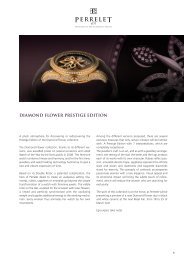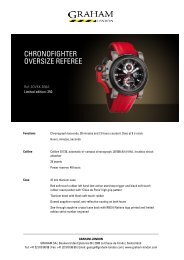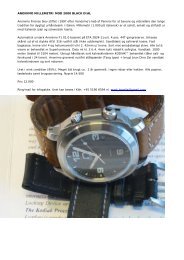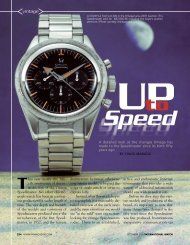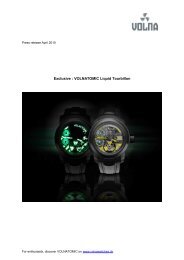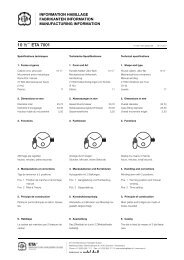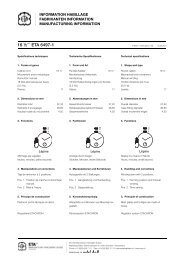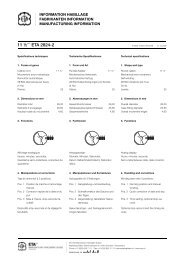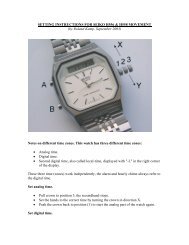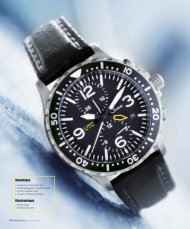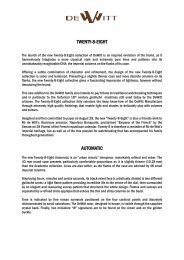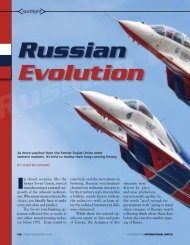A squadron of pilots' watches soars into the - Watchuseek, World's ...
A squadron of pilots' watches soars into the - Watchuseek, World's ...
A squadron of pilots' watches soars into the - Watchuseek, World's ...
You also want an ePaper? Increase the reach of your titles
YUMPU automatically turns print PDFs into web optimized ePapers that Google loves.
78 WatchTime April 2008<br />
A <strong>squadron</strong> <strong>of</strong> pilots’ <strong>watches</strong> <strong>soars</strong> <strong>into</strong> <strong>the</strong> skies along with our test<br />
pilot, Klaus Lenhart. The <strong>watches</strong> are from Graham, Victorinox Swiss<br />
Army, Chronoswiss, Glashütte Original, Breitling, IWC, Sinn, Fortis,<br />
Oris, Limes, Hamilton and Longines.<br />
Test pilot Klaus<br />
Lenhart, sporting<br />
multiple <strong>watches</strong>,<br />
prepares for take<strong>of</strong>f
Lenhart put <strong>the</strong> <strong>watches</strong> through<br />
<strong>the</strong>ir paces in a series <strong>of</strong> aerobatic<br />
flights over <strong>the</strong> German countryside.<br />
BY MARTINA RICHTER<br />
PHOTOS BY FRANK HERZOG, MAIK RICHTER,<br />
THOMAS WANKA, ZUCKERFABRIK FOTODESIGN<br />
What better way to test a pilot watch’s<br />
moxie than to take it up for a grueling,<br />
stomach-wrenching aerobatics routine<br />
high above <strong>the</strong> German countryside?<br />
That aim in mind, we took 12 pilots’<br />
<strong>watches</strong> — eight <strong>of</strong> <strong>the</strong>m chronographs<br />
— to <strong>the</strong> Gruibingen-Nortel airport in<br />
southwestern Germany, where aerobatics<br />
champion Klaus Lenhart awaited us with<br />
his trusty 300-horsepower HP LEKI Extra<br />
300L, ready to take <strong>the</strong> <strong>watches</strong> up <strong>into</strong><br />
<strong>the</strong> not-so-friendly skies. During <strong>the</strong><br />
workout, all <strong>the</strong> <strong>watches</strong> had to withstand<br />
<strong>the</strong> same G-forces, that is, <strong>the</strong> loads<br />
resulting from acceleration. In aerobatics<br />
<strong>the</strong>se forces can fluctuate between +7 and<br />
-4.5 G. We measured each watch’s rate on<br />
an electronic timing machine before and<br />
immediately after <strong>the</strong> flight, and <strong>the</strong>n<br />
again later, and compared <strong>the</strong> values. For<br />
<strong>the</strong> chronographs, we tested factors such<br />
as how easy <strong>the</strong> pushers are to operate<br />
and how legible <strong>the</strong>ir displays are. There<br />
was also a to-<strong>the</strong>-second, real-time comparison<br />
with a radio-controlled clock. We<br />
also asked <strong>the</strong> pilot for his opinion <strong>of</strong><br />
each watch with respect to its functions,<br />
readability and comfort.<br />
April 2008 WatchTime 79
REVIEW<br />
Pilots’ Watches<br />
PROS:<br />
+ Unique design<br />
+ Chronometer<br />
+ Rate results<br />
+ Special added module<br />
+ Double display <strong>of</strong> chronograph<br />
function<br />
+ Rotating bezel<br />
+ Slide rule<br />
+ Date<br />
+ Water-resistant to 20 ATM<br />
+ Nonreflective sapphire crystal<br />
+ Day/night legibility<br />
+ Screw-down crown<br />
+ Overall operation<br />
+ Bracelet/locking clasp<br />
CONS:<br />
- A bit heavy on <strong>the</strong> wrist<br />
Breitling Skyracer<br />
The Skyracer belongs to Breitling’s Pr<strong>of</strong>essional collection <strong>of</strong> <strong>watches</strong>. Like all<br />
Breitling <strong>watches</strong>, our test model was a chronometer. The watch has an unusual<br />
totalizer, which shows, by means <strong>of</strong> two hands and two concentric scales,<br />
both elapsed minutes and elapsed hours. That way <strong>the</strong> wearer can read elapsed<br />
time at a single glance. The Skyracer has ano<strong>the</strong>r unorthodox feature: a centermounted<br />
chronograph minutes hand. The watch also has a slide rule and a<br />
graduated, rotating bezel. Added to this are a date display, a screw-down double-sealed<br />
crown that makes <strong>the</strong> watch water-resistant to 200 meters, and a<br />
crystal that is glare-pro<strong>of</strong> on both sides. In keeping with <strong>the</strong> watch’s aeronautical<br />
<strong>the</strong>me, <strong>the</strong> threaded caseback bears <strong>the</strong> symbols <strong>of</strong> <strong>the</strong> Ground-Air Visual<br />
Signal Code, which accident survivors use to send messages to airplanes flying<br />
overhead. Despite <strong>the</strong> many numbers and scales on <strong>the</strong> dial, <strong>the</strong> time display is<br />
easy to read, even in <strong>the</strong> dark. The tips <strong>of</strong> <strong>the</strong> chrono seconds and minute hands<br />
hide <strong>the</strong> triangular index marking <strong>the</strong> 12, but our test pilot didn’t find this a<br />
problem. He praised <strong>the</strong> readability and attractive design <strong>of</strong> <strong>the</strong> dial, its easy-touse<br />
chronograph function and <strong>the</strong> stainless-steel bracelet. His only caveat:<br />
“You have to get used to <strong>the</strong> watch’s considerable weight.”<br />
The rate results <strong>of</strong> <strong>the</strong> Skyracer remained true to <strong>the</strong> promises <strong>of</strong> <strong>the</strong><br />
chronometer certificate. On average, <strong>the</strong> watch gained three seconds per day before<br />
<strong>the</strong> flight, 4.6 seconds immediately after it and 1.6 seconds a bit later. When<br />
<strong>the</strong> chronometer was engaged, <strong>the</strong> watch ran a bit faster (an average <strong>of</strong> 5.8 seconds).<br />
The amplitudes declined somewhat, though <strong>the</strong>y remained quite good at<br />
between 265 and 295 degrees. Without <strong>the</strong> chronograph <strong>the</strong>y stayed between<br />
<strong>the</strong> relatively high levels <strong>of</strong> 300 and 340 degrees.<br />
80 WatchTime April 2008<br />
In <strong>the</strong> dark, <strong>the</strong> Skyracer’s hands<br />
and indices glow brightly.<br />
The Skyracer from Breitling’s Pr<strong>of</strong>essional line is<br />
both very useful and quite easy to read. As a<br />
chronometer it shows good rate results, and as a<br />
pr<strong>of</strong>essional gauge it’s easy to operate. Plus, it’s<br />
water-resistant to 200 meters and comfortable<br />
despite its considerable weight.<br />
SPECS<br />
BREITLING SKYRACER<br />
Manufacturer: Breitling<br />
Reference number: 2153665<br />
Functions: Hours, minutes, seconds, date,<br />
chronograph, circular slide rule<br />
Movement: Breitling 27, based on ETA<br />
2892-A2, automatic; diameter = 25.6<br />
mm; height = 3.60 mm (without module);<br />
38 jewels; 28,800 vph; 42-hour power<br />
reserve; Glucydur balance; Nivarox<br />
balance spring; Incabloc shock protection;<br />
Etachron fine adjustment; côtes<br />
de Genève and perlage; chronometer<br />
certification<br />
Case: Stainless steel with double nonreflective<br />
crystal, water-resistant to 20 ATM<br />
Bracelet and clasp: Stainless steel<br />
bracelet with locking folding clasp<br />
Dimensions: Diameter = 43.5 mm, height<br />
= 16 mm, weight = 223.5 grams<br />
Price: $4,960<br />
The Skyracer registers elapsed time twice —<br />
with <strong>the</strong> easy-to-read chronograph seconds and<br />
minutes hands mounted in <strong>the</strong> center, and with<br />
ano<strong>the</strong>r hour and minutes display on a subdial<br />
at 9 o’clock.
REVIEW<br />
Pilots’ Watches<br />
PROS:<br />
+ Striking design<br />
+ Controls<br />
+ Indicator date<br />
+ Sapphire crystal, nonreflective<br />
+ Luminous numerals and hands<br />
+ Water-resistant to 10 ATM<br />
+ Factory finishing<br />
+ Rate results<br />
+ Screwed lea<strong>the</strong>r strap<br />
CONS:<br />
- Day/night legibility<br />
- Price<br />
Chronoswiss Timemaster Date<br />
The large case, pushers and crown <strong>of</strong> this watch make it easy<br />
to operate, but it’s not so easy to read. You need more than a<br />
quick glance at <strong>the</strong> dial to get your bearings. There are so<br />
many scales and numbers — large and densely laid-out — that<br />
deciphering <strong>the</strong>m can be a challenge, especially in <strong>the</strong> dark,<br />
since some <strong>of</strong> <strong>the</strong> luminous markers overlap. Ano<strong>the</strong>r drawback:<br />
<strong>the</strong> fluted bezel turns too easily and can thus be inadvertently<br />
knocked <strong>of</strong>f position. The proportions <strong>of</strong> <strong>the</strong><br />
Timemaster Date, like those <strong>of</strong> all Chronoswiss <strong>watches</strong>, are<br />
attractive, but <strong>the</strong>re is simply too much <strong>of</strong> everything.<br />
The rate results were none<strong>the</strong>less good. Prior to <strong>the</strong> aerobatics<br />
flight <strong>the</strong> Timemaster Chronograph showed a gain <strong>of</strong><br />
4.2 seconds per day. Directly after <strong>the</strong> flight <strong>the</strong> rate increased<br />
by 3.6 seconds, which some time later leveled <strong>of</strong>f at 3.4 seconds.<br />
The overall deviation in all positions was quite balanced:<br />
rates were recorded between +3 and +6 seconds per<br />
day. The amplitude fluctuated between 300 degrees in <strong>the</strong><br />
crown positions and 335 degrees in <strong>the</strong> dial positions and performed<br />
identically in any situation. The only exception: when<br />
<strong>the</strong> chronograph was running, <strong>the</strong> amplitude fell by about 20<br />
degrees and <strong>the</strong> rate increased, showing a gain <strong>of</strong> five seconds.<br />
The pilot liked <strong>the</strong> strap, which is attached to <strong>the</strong> lugs with<br />
screws and is equipped with a pronged buckle.<br />
82 WatchTime April 2008<br />
The Timemaster’s hands and<br />
indices glow strong in <strong>the</strong> dark,<br />
but some <strong>of</strong> <strong>the</strong>m overlap.<br />
The Timemaster Date<br />
chronograph indicates<br />
<strong>the</strong> date by means <strong>of</strong> a<br />
center-mounted hand<br />
and a 31-day scale<br />
encircling <strong>the</strong> dial.<br />
SPECS<br />
The watch is an impressive companion<br />
for any pilot, but it’s brimming with so<br />
many displays that he may strain his<br />
eyes reading it. The pushers and crown<br />
are easy to operate. The handmade<br />
lea<strong>the</strong>r strap is supple, water-resistant<br />
and attached to <strong>the</strong> case with screws.<br />
CHRONOSWISS TIMEMASTER DATE<br />
Manufacturer: Chronoswiss<br />
Reference number: CH 7533 bk<br />
Functions: Hours, minutes, seconds,<br />
chronograph, center-mounted hand to indicate<br />
date<br />
Movement: C.751, based on ETA/Valjoux<br />
7750, automatic; diameter = 30 mm;<br />
height = 7.9 mm; 25 jewels; 28,800 vph;<br />
46-hour power reserve; Glucydur balance;<br />
Nivarox balance spring; Incabloc shock<br />
protection; Eccentric fine adjustment;<br />
cotes de Geneve and perlage, skeletonized<br />
rotor<br />
Case: Stainless steel with nonreflective<br />
sapphire crystal, water-resistant to 10<br />
ATM<br />
Strap and clasp: Walknappa lea<strong>the</strong>r strap<br />
with pronged buckle<br />
Dimensions: Diameter = 44 mm, height =<br />
16 mm, weight = 117 g<br />
Price: $6,950
REVIEW<br />
Pilots’ Watches<br />
PROS:<br />
+ Classic aviator design<br />
+ Day/date<br />
+ Rate results<br />
+ Day/night legibility<br />
+ Sapphire crystal (top)<br />
+ Crystal caseback<br />
+ Water-resistant to 20 ATM<br />
+ Operability<br />
+ Strap<br />
+ Double-folding clasp<br />
+ Value<br />
CONS:<br />
- Rate results after test flight<br />
slightly in minus range<br />
Fortis B-42 Flieger<br />
This new version <strong>of</strong> <strong>the</strong> Flieger chronograph is <strong>the</strong> latest update<br />
<strong>of</strong> this classic, decades-old model. Behind <strong>the</strong> double-sided,<br />
glare-pro<strong>of</strong> sapphire crystal, <strong>the</strong> numerals, indices and hands<br />
draw your attention and are easy to read. In <strong>the</strong> dark, <strong>the</strong> hands<br />
appear slightly brighter than <strong>the</strong> dial markings. The chronograph<br />
seconds hand and small seconds dial are not luminous.<br />
The pilot praised <strong>the</strong> dial’s design, especially <strong>the</strong> hands, which<br />
are easy to tell apart.<br />
The chronograph pushers click precisely <strong>into</strong> place and <strong>the</strong><br />
large crown is easy to operate, though it does not screw down.<br />
The strap is also well designed and has a comfortable doublefolding<br />
clasp. It is attached to <strong>the</strong> lugs with screws.<br />
The watch contains <strong>the</strong> movement that has proven itself a<br />
million times over: <strong>the</strong> ETA 7750, which showed good rate results.<br />
Prior to <strong>the</strong> flight <strong>the</strong> watch gained an average <strong>of</strong> 4.6 seconds<br />
per day, regardless <strong>of</strong> whe<strong>the</strong>r <strong>the</strong> chronograph was running<br />
or not. Directly after <strong>the</strong> aerobatics flight we measured a<br />
small loss <strong>of</strong> 0.2 seconds. After some time had passed, <strong>the</strong> watch<br />
returned to an average gain <strong>of</strong> 2 seconds. The amplitude remained<br />
stable in every situation, between 310 degrees in <strong>the</strong> dial<br />
positions and 280 degrees in <strong>the</strong> crown positions. When <strong>the</strong><br />
chronograph was engaged <strong>the</strong> amplitude fell by about 20 degrees.<br />
The movement can be viewed through a transparent caseback<br />
and is equipped with an engraved rotor.<br />
84 WatchTime April 2008<br />
With its big numerals and triangle,<br />
<strong>the</strong> Fortis’s dial looks great at night.<br />
The Fortis B-42 Flieger<br />
chronograph pushers<br />
click <strong>into</strong> place very<br />
precisely. The lea<strong>the</strong>r<br />
strap has a secure<br />
folding clasp and lugs<br />
with screws.<br />
SPECS<br />
FORTIS B-42 FLIEGER<br />
Manufacturer: Fortis<br />
The “42” in <strong>the</strong> name<br />
“B-42” refers to <strong>the</strong> watch’s<br />
diameter. The time is easy to<br />
read, but making out <strong>the</strong><br />
additional functions, such<br />
as <strong>the</strong> chronograph, day and<br />
date, requires a keener eye.<br />
A tachymeter scale is located<br />
on <strong>the</strong> flange along <strong>the</strong> rim<br />
<strong>of</strong> <strong>the</strong> dial.<br />
Reference number: 656.10.11 L01<br />
Functions: Hours, minutes, seconds, date,<br />
chronograph<br />
Movement: ETA/Valjoux 7750, automatic;<br />
diameter = 30 mm; height = 7.9 mm; 25<br />
jewels; 28,800 vph; 48-hour power reserve;<br />
gold-plated nickel balance; Nivarox<br />
balance spring; Incabloc shock protection;<br />
two-part regulator fine adjustment;<br />
blued screws; engraved rotor<br />
Case: Stainless steel with nonreflective<br />
mineral glass crystal, water-resistant to<br />
20 ATM<br />
Strap and clasp: Lea<strong>the</strong>r strap with double-folding<br />
clasp<br />
Dimensions: Diameter = 42.3 mm, height<br />
= 15.3 mm, weight = 138.5 g<br />
Price: $2,650
REVIEW<br />
Pilots’ Watches<br />
This pilot’s watch from Glashütte<br />
Original is patterned after<br />
historic predecessors. It’s large,<br />
functional and, above all,<br />
highly legible.<br />
PROS:<br />
+ Classic pilots’ watch design<br />
+ Manufacture caliber<br />
+ Movement finishing<br />
+ Panorama date<br />
+ Return-to-zero mechanism<br />
+ Day/night legibility<br />
+ Water-resistant to 5 ATM<br />
+ Sapphire crystal above dial<br />
+ Operable via crown<br />
+ High-quality strap<br />
CONS:<br />
- High price<br />
- Rate results showed strong loss<br />
Nighttime readability is good, and <strong>the</strong><br />
triangle at 12 makes orientation easy.<br />
86 WatchTime April 2008<br />
The Senator Navigator has a<br />
central seconds hand coupled<br />
with a return-to-zero mechanism.<br />
If you press <strong>the</strong> push-piece at <strong>the</strong><br />
8, <strong>the</strong> seconds hand instantly<br />
jumps to <strong>the</strong> 12 o’clock position<br />
to facilitate setting <strong>the</strong> watch with<br />
to-<strong>the</strong>-second precision.<br />
SPECS<br />
GLASHÜTTE ORIGINAL SENATOR NAVIGATOR<br />
Manufacturer: Glashütte Original<br />
Reference number: 100-03-07-04-04<br />
Functions: Hours, minutes, seconds, big<br />
date<br />
Movement: GO 100-03, automatic; diameter<br />
= 31.15 mm; height = 5.80 mm; 51<br />
jewels; 28,800 vph; 55-hour power reserve;<br />
Glucydur balance; Nivarox balance<br />
spring; Incabloc shock protection; swan’s<br />
neck fine adjustment; Glashütte waves,<br />
beveled edges, skeletonized rotor<br />
Case: Stainless steel with sapphire crystal,<br />
water-resistant to 5 ATM<br />
Strap and clasp: calfskin lea<strong>the</strong>r strap<br />
with pronged buckle<br />
Dimensions: Diameter = 43.89 mm,<br />
height = 12.95 mm, weight = 100 grams<br />
Price: $8,500<br />
Glashütte Original Senator Navigator<br />
Panorama Date<br />
Drawing on a long tradition, Saxony-based Glashütte Original patterns its<br />
Navigator after a historic predecessor. Traditional elements include a matte<br />
black dial made <strong>of</strong> nickel silver and printed with Arabic numerals and stroke<br />
indices for <strong>the</strong> minutes and seconds. Like o<strong>the</strong>r historic models, all <strong>of</strong> its evennumbered<br />
hour numerals, minute-circle, and hands for hours, minutes and<br />
seconds are coated with luminous material, ensuring very good nighttime<br />
readability. Orientation is made easy by <strong>the</strong> prominent triangle at 12 o’clock.<br />
In addition to his praise for <strong>the</strong> excellent legibility, our pilot also lauded <strong>the</strong><br />
impressively large dial and <strong>the</strong> appearance <strong>of</strong> <strong>the</strong> black-on-white date display.<br />
His concise verdict: “A good and elegant pilot’s watch.”
REVIEW<br />
Pilots’ Watches<br />
PROS:<br />
+ Unique, modern bicompax chronograph<br />
+ Innovative materials<br />
+ Sapphire crystal, nonreflective<br />
+ Day/night legibility<br />
+ Easy to operate<br />
+ Water-resistant to 10 ATM<br />
+ Strap/clasp<br />
CONS:<br />
- Rate is too fast<br />
- No date display<br />
- High price<br />
Every hand and index on <strong>the</strong> Graham watch<br />
glows like a neon sign in <strong>the</strong> dark.<br />
88 WatchTime April 2008<br />
Graham Chron<strong>of</strong>ighter Oversize<br />
Commander<br />
The Graham Chron<strong>of</strong>ighter Oversize Commander richly deserves its aeronautical<br />
name, and our test pilot gave it a thumbs-up. However, he was glad that<br />
<strong>the</strong> watch, with its diameter <strong>of</strong> 46 mm, wasn’t any bigger. “If a watch is too<br />
big, it will scratch during <strong>the</strong> intense action <strong>of</strong> aerobatics,” Lenhart says. He<br />
liked that <strong>the</strong> watch is very easy to operate, thanks to <strong>the</strong> gigantic pusher on<br />
<strong>the</strong> left side <strong>of</strong> <strong>the</strong> case. The composition <strong>of</strong> lightweight materials, including almost-pure<br />
titanium, carbon fiber and natural rubber, keeps <strong>the</strong> watch from being<br />
too heavy.<br />
The watch is easy enough to read, even under poor conditions, since all <strong>the</strong><br />
hands and markers are highly luminous. The watch showed gains <strong>of</strong> more than<br />
nine seconds per day both before and after <strong>the</strong> flight. It ran nine to 12 seconds<br />
fast in every position we measured on <strong>the</strong> timing machine except <strong>the</strong> crown-up<br />
one. The amplitude remained relatively stable at around 300 degrees, but with<br />
<strong>the</strong> chronograph running it fell by about 20 degrees. The rate also declined and<br />
stayed at around +6 seconds per day. Unfortunately, <strong>the</strong> Graham Caliber 1732<br />
has no date display.<br />
The ETA-based Graham<br />
Caliber 1732 has a 30minute<br />
counter at 9 o’clock.<br />
Its constant-seconds subdial is<br />
at <strong>the</strong> three. The watch rests<br />
securely on <strong>the</strong> arm thanks to a<br />
hypoallergenic non-slip<br />
rubber strap and simple<br />
pronged buckle.<br />
The Chron<strong>of</strong>ighter has a special<br />
crown lever construction on <strong>the</strong><br />
left side <strong>of</strong> <strong>the</strong> case, which is <strong>of</strong><br />
good quality. The manufacturer<br />
combines innovative materials<br />
such as carbon fiber and<br />
titanium for greater durability<br />
and less weight.<br />
SPECS<br />
GRAHAM CHRONOFIGHTER COMMANDER<br />
Manufacturer: Graham<br />
Reference number: 20VATCO.B01A.K10B<br />
Functions: Hours, minutes, seconds,<br />
chronograph<br />
Movement: G 1732, based on ETA/Valjoux<br />
7750, automatic; diameter = 30 mm;<br />
height = 8.70 mm; 30 jewels; 28,800 vph;<br />
48-hour power reserve; Glucydur balance;<br />
Nivarox balance spring; annular hairspring,<br />
Incabloc shock protection;<br />
Etachron fine adjustment; perlage and<br />
côtes de Genève on rotor<br />
Case: Titanium and carbon fiber with sapphire<br />
crystal, nonreflective on both sides;<br />
water-resistant to 10 ATM<br />
Strap and clasp: Natural rubber with<br />
pronged buckle<br />
Dimensions: Diameter = 46 mm, height =<br />
8.7 mm, weight = 132 grams<br />
Price: $10,400
REVIEW<br />
Pilots’ Watches<br />
PROS:<br />
+ Navigation function<br />
+ Day/date<br />
+ Screw-down crowns<br />
+ Legibility during <strong>the</strong> day<br />
+ Water-resistant to 10 bar<br />
+ Rate results<br />
+ Strap/extension piece<br />
+ Sapphire crystals<br />
+ Price<br />
CONS:<br />
- Legibility at night<br />
- Complexity <strong>of</strong> navigation<br />
function<br />
Hamilton Khaki X-Wind Automatic<br />
The Khaki X-Wind might make your head spin if you tried to understand all its<br />
numerals and scales at once. It houses an ingenious integrated navigation system<br />
that is used to calculate and log crosswinds. To do this you need <strong>the</strong> wind<br />
directions, speeds, a map and a control tower. Our pilot found this process<br />
overly complicated. “I had to get used to <strong>the</strong> yellow dial,” our pilot said, “but<br />
<strong>the</strong> black hands do show up well against it.” However, if you think <strong>the</strong> dial will<br />
show up brightly at night, think again. It’s impossible to read <strong>the</strong> time in <strong>the</strong><br />
dark, since <strong>the</strong> only markers that glow, albeit weakly, are 12 small dots marking<br />
<strong>the</strong> hours.<br />
Something else to get used to: <strong>the</strong> chronograph pushers, which, along with<br />
<strong>the</strong> crown, are on <strong>the</strong> left side <strong>of</strong> <strong>the</strong> case, not <strong>the</strong> right. That side is instead used<br />
for two screw-down crowns with crown guards that adjust <strong>the</strong> rotating bezels<br />
for <strong>the</strong> navigation function.<br />
The Hamilton watch contains an ETA 7750 movement, which produced<br />
<strong>the</strong> good rates you’d expect from it. It showed steady rates in all positions at<br />
+4.8 seconds per day before <strong>the</strong> flight, +4.4 seconds immediately after landing,<br />
+3.8 seconds a few days later and +4.0 seconds while <strong>the</strong> chronograph was in<br />
operation. The amplitude also remained stable — at around 310 degrees in <strong>the</strong><br />
dial positions and 285 degrees in <strong>the</strong> crown positions. The amplitude fell an average<br />
<strong>of</strong> 10 degrees immediately after <strong>the</strong> aerobatics flight and about 20 degrees<br />
when <strong>the</strong> chronograph was in operation.<br />
90 WatchTime April 2008<br />
Without luminous hands, you can’t read<br />
<strong>the</strong> time in <strong>the</strong> dark on <strong>the</strong> Khaki X-Wind;<br />
only small dots on <strong>the</strong> edge <strong>of</strong> <strong>the</strong> dial are<br />
visible.<br />
SPECS<br />
The yellow dial and <strong>the</strong> many scales<br />
<strong>of</strong> <strong>the</strong> Khaki X-Wind are eye-catching.<br />
The time display is clear, at<br />
least in good light. The watch has a<br />
sturdy riveted strap with an H-shaped<br />
double-pronged buckle. An extension<br />
piece on <strong>the</strong> strap makes it possible to<br />
wear <strong>the</strong> watch over a flight jacket.<br />
HAMILTON KHAKI X-WIND AUTOMATIC<br />
Manufacturer: Hamilton<br />
Reference number: H77666523<br />
Functions: Hours, minutes, seconds,<br />
day/date, chronograph<br />
Movement: ETA/Valjoux 7750, automatic;<br />
diameter = 30 mm; height = 7.9 mm; 25<br />
jewels; 28,800 vph; 48-hour power reserve;<br />
gold-plated nickel balance; Nivarox<br />
balance spring; annular hairspring; Incabloc<br />
shock protection; two-part regulator<br />
fine adjustment; engraved rotor<br />
Case: Anti-rust steel with sapphire crystal,<br />
water-resistant to 10 ATM<br />
Strap and clasp: Lea<strong>the</strong>r with doubleprong<br />
clasp and extension piece<br />
Dimensions: Diameter = 44.5 mm, height<br />
= 15.7 mm, weight = 143.0 g<br />
Price: $1,395<br />
Three adjustable bezels, two <strong>of</strong> which are<br />
located beneath <strong>the</strong> sapphire crystal, and an<br />
engraved monogram on <strong>the</strong> threaded caseback<br />
enable a pilot to navigate, though <strong>the</strong> system<br />
requires special expertise.
REVIEW<br />
Pilots’ Watches<br />
PROS:<br />
+ Classic pilots’ watch design<br />
+ Movement finishing<br />
+ Protection against magnetic fields<br />
+ Nonreflective sapphire crystal<br />
+ Stable rate results<br />
+ Water-resistant to 6 ATM<br />
+ Sapphire crystal above dial<br />
+ Screwable crown<br />
+ High-quality crocodile strap<br />
CONS:<br />
- Date display is too small<br />
- High price<br />
The triangle glows in <strong>the</strong> dark, as do <strong>the</strong><br />
three o<strong>the</strong>r main index strokes and <strong>the</strong><br />
hour and minute hands.<br />
IWC Mark XVI Pilot’s Watch<br />
The Mark XVI is a classic model from Schaffhausen-based IWC, which has<br />
been making pr<strong>of</strong>essional time-measuring instruments for pilots and travelers<br />
since <strong>the</strong> 1930s. The most famous <strong>of</strong> <strong>the</strong>se <strong>watches</strong> is <strong>the</strong> Mark 11, launched in<br />
1948. The Mark XVI, <strong>the</strong> successor <strong>of</strong> <strong>the</strong> Mark XV, is one millimeter larger<br />
than its predecessor. “It really shouldn’t be any smaller,” our test pilot remarked.<br />
As befits a pilot’s watch, <strong>the</strong> Mark XVI is “tidy, sleekly functional and<br />
very highly legible. Its hands have perfect lengths and clearly differ from one<br />
ano<strong>the</strong>r.” They glow brightly in <strong>the</strong> dark, as do <strong>the</strong> indices at 3, 6 and 9 o’clock<br />
and <strong>the</strong> triangle at 12 o’clock. The o<strong>the</strong>r indices and <strong>the</strong> Arabic numerals remain<br />
dark, but this doesn’t detract from <strong>the</strong> overall legibility. The date display<br />
is a bit too small.<br />
The movement, Caliber 30110 (based on an ETA caliber), is protected<br />
against magnetic fields by a s<strong>of</strong>t iron cage, and its rate is extraordinarily stable.<br />
It ran slightly ahead in all situations: on <strong>the</strong> timing machine, its daily gain<br />
measured 2.6 seconds before <strong>the</strong> test flight, 2.8 seconds immediately afterwards<br />
and 3.6 seconds several days after <strong>the</strong> flight. The amplitudes varied between<br />
300 degrees in <strong>the</strong> dial positions and 270 degrees in <strong>the</strong> crown positions;<br />
<strong>the</strong>y behaved similarly in all situations. The embellished caliber is hidden behind<br />
stainless steel and s<strong>of</strong>t iron. The case is water-resistant to 60 meters (6<br />
ATM). The domed, nonreflective pane <strong>of</strong> sapphire crystal guarantees good visibility<br />
and won’t easily pop <strong>of</strong>f if <strong>the</strong> atmospheric pressure suddenly plunges.<br />
92 WatchTime April 2008<br />
SPECS<br />
The Mark XVI boasts a classic design<br />
and produces stable rate results. Its<br />
matte stainless-steel case contains a<br />
s<strong>of</strong>t iron sheath that keeps magnetism<br />
from interfering with <strong>the</strong> performance<br />
<strong>of</strong> <strong>the</strong> movement. The grooved crown<br />
can be screwed shut.<br />
IWC MARK XVI PILOT’S WATCH<br />
Manufacturer: IWC Schaffhausen<br />
Reference number: IW 325501<br />
Functions: Hours, minutes, seconds, date<br />
Movement: IWC 30110, based on ETA<br />
2892-A2, automatic; diameter = 25.6<br />
mm; height = 3.6 mm; 23 jewels; 28,800<br />
vph; 42-hour power reserve; Glucydur<br />
balance; Nivarox balance spring; Incabloc<br />
shock protection; Etachron fine adjustment;<br />
waves and circular graining on<br />
movement<br />
Case: Stainless steel with nonreflective<br />
sapphire crystal, water-resistant to 6 ATM<br />
Strap and clasp: Crocodile lea<strong>the</strong>r strap<br />
with pronged buckle<br />
Dimensions: Diameter = 39.2 mm, height<br />
= 10.6 mm, weight = 66.5 grams<br />
Price: $3,400<br />
Numerals and indices, neatly applied to <strong>the</strong> dial’s<br />
matte black background, combine with bold hands<br />
to ensure maximum legibility in all situations —<br />
even on <strong>the</strong> wrist <strong>of</strong> a stunt pilot.
REVIEW<br />
Pilots’ Watches<br />
DATA<br />
LIMES CLASSIC VINTAGE 1924<br />
Manufacturer: Limes<br />
Reference number: U7624R-LA4.2<br />
Functions: Hours, minutes, seconds, date<br />
Movement: Sellita SW 200, automatic;<br />
diameter = 25.6 mm; height = 4.6 mm; 25<br />
jewels; 28,800 vph; 49-hr power reserve;<br />
Nickel dore balance; Nivarox balance<br />
spring; Incabloc shock protection;<br />
Etachron fine adjustment; côtes de<br />
Genève and circular graining, blued<br />
screws<br />
Case: Stainless steel with sapphire crystal,<br />
water-resistant to 5 ATM<br />
Strap and clasp: Lea<strong>the</strong>r strap with<br />
pronged buckle<br />
Dimensions: Diameter = 38 mm, height =<br />
9.67 mm, weight = 61 grams<br />
Price: $870<br />
Among <strong>the</strong> features <strong>of</strong> <strong>the</strong> Limes case are<br />
screwed strap lugs and a knurled top ring that<br />
surrounds a sapphire crystal. A second sapphire<br />
crystal is set <strong>into</strong> <strong>the</strong> back <strong>of</strong> <strong>the</strong> partly matte<br />
and partly polished stainless-steel case.<br />
Our test pilot praised <strong>the</strong> Limes model as<br />
an “elegant watch with an aviator’s<br />
image.” He specifically lauded its impeccable<br />
legibility, classically designed case<br />
and secure lea<strong>the</strong>r strap. It takes some<br />
effort to extract <strong>the</strong> onion crown <strong>into</strong> <strong>the</strong><br />
positions required to quickly reset <strong>the</strong><br />
date display and to set <strong>the</strong> hands.<br />
94 WatchTime April 2008<br />
Limes Classic Vintage 1924<br />
Limes has been making its own watch cases since 1924; hence, this model’s<br />
name. The watch attracts attention with a beautiful case distinguished by<br />
a fluted bezel, finely crafted lugs and an onion crown. The large, ornamental<br />
numerals on <strong>the</strong> black dial recall <strong>the</strong> look <strong>of</strong> instruments that measured<br />
flight time decades ago. Toge<strong>the</strong>r with <strong>the</strong> lancet-shaped hands, <strong>the</strong>y<br />
make <strong>the</strong> time easily legible, even in poor-visibility conditions. The hands<br />
glow somewhat brighter than <strong>the</strong> numerals. The date display, with its<br />
white digits against a black background, is easy to miss in <strong>the</strong> dark, and it<br />
occupies a less-than-ideal location between <strong>the</strong> 4 o’clock and 5 o’clock positions.<br />
The watch’s elegance is reflected in its smooth, brown lea<strong>the</strong>r strap,<br />
which is securely screwed to <strong>the</strong> lugs; its two ends are joined with a<br />
pronged buckle.<br />
The rate results <strong>of</strong> this watch’s Sellita movement aren’t quite so elegant.<br />
It lost time right from <strong>the</strong> start and in all positions. The deviations averaged<br />
1.8 seconds per day before <strong>the</strong> test flight and increased to 4.2 seconds<br />
immediately afterward. A subsequent test on <strong>the</strong> electronic timing machine<br />
revealed an average daily loss <strong>of</strong> 3.6 seconds. The amplitude varied between<br />
320° in <strong>the</strong> dial positions and about 300° in <strong>the</strong> crown positions.<br />
The amplitude declined by an additional 30° in all positions immediately<br />
after <strong>the</strong> test flight. The movement is visible through <strong>the</strong> sapphire crystal in<br />
<strong>the</strong> back <strong>of</strong> <strong>the</strong> case, which is water-resistant to 50 meters (5 ATM).<br />
PROS:<br />
+ Case made in-house<br />
+ Elegant outfitting<br />
+ Screwed strap lugs<br />
+ Day/night legibility<br />
+ Water-resistant to 5 ATM<br />
+ Sapphire crystals<br />
+ Long, secure strap<br />
CONS:<br />
- Rate results showed loss<br />
- Amplitudes varied<br />
- Small date display<br />
- Crown difficult to operate<br />
The lancet-shaped hands glow a bit<br />
brighter in <strong>the</strong> dark than <strong>the</strong> numerals.
REVIEW<br />
Pilots’ Watches<br />
Longines Lindbergh Hour<br />
Angle Watch<br />
Longines’s reissue <strong>of</strong> <strong>the</strong> historic Charles Lindbergh Hour Angle Watch in its<br />
original size is a real eye-catcher, and not only because <strong>of</strong> its 47.5-mm diameter.<br />
The numerous scales and <strong>the</strong> functions <strong>the</strong>y perform require explanation:<br />
<strong>the</strong> longitude is shown in minutes <strong>of</strong> arc, <strong>the</strong> rotating bezel takes <strong>into</strong> account<br />
<strong>the</strong> equation <strong>of</strong> time, and <strong>the</strong> central portion <strong>of</strong> <strong>the</strong> dial can be rotated to synchronize<br />
<strong>the</strong> seconds hand. “All this isn’t necessary in <strong>the</strong> cockpit,” our test pilot<br />
explained, but he acknowledged that this watch’s “aes<strong>the</strong>tic playfulness”<br />
will surely find an audience. The back <strong>of</strong> <strong>the</strong> watch has a surprise in store:<br />
open <strong>the</strong> hinged back and peek through <strong>the</strong> domed pane <strong>of</strong> sapphire crystal,<br />
and you’ll find a generously proportioned movement with a gigantic rotor.<br />
The watch achieved a remarkably good rate and it behaved identically in<br />
all positions. It gained an average <strong>of</strong> 3.8 seconds per day before <strong>the</strong> test flight,<br />
ran 3.6 seconds faster when tested on <strong>the</strong> timing machine immediately afterward,<br />
and scored an average daily gain <strong>of</strong> 4.2 seconds a few days after <strong>the</strong><br />
flight. Its amplitudes were also very stable: under all conditions, <strong>the</strong>y were 305<br />
degrees in <strong>the</strong> dial positions and 280 degrees in <strong>the</strong> crown positions.<br />
Beautiful details adorn <strong>the</strong> watch’s face. The white lacquered dial is painted<br />
with a black-lacquered minute circle and 12 Roman numerals for <strong>the</strong><br />
hours, as well as blue Arabic numerals for <strong>the</strong> longitudes. A silver-plated inner<br />
disk bearing black and red digits can be rotated. Breguet hands made <strong>of</strong> blued<br />
steel complete <strong>the</strong> pretty picture. Only one detail is lacking: <strong>the</strong>re’s no luminous<br />
paint anywhere on <strong>the</strong> dial.<br />
PROS:<br />
+ Based on historic predecessor<br />
+ Longitude function<br />
+ Equation <strong>of</strong> time<br />
+ Time synchronization<br />
+ Stable rate behavior<br />
+ Sapphire crystals<br />
+ Crown operates easily<br />
+ Strap with extension piece<br />
CONS:<br />
- No nighttime legibility<br />
No luminous material anywhere on <strong>the</strong><br />
Lindbergh’s big dial means this watch is<br />
unreadable in <strong>the</strong> dark.<br />
96 WatchTime April 2008<br />
SPECS<br />
LONGINES LINDBERGH HOUR ANGLE WATCH<br />
Manufacturer: Longines<br />
Reference number: L2.678.4.11.2<br />
Functions: Hours, minutes, seconds,<br />
longitude function, equation <strong>of</strong> time<br />
Movement: L699.2, based on ETA<br />
A07.111, automatic; diameter = 36.6 mm;<br />
height = 7.9 mm; 24 jewels; 28,800 vph;<br />
42-hour power reserve; Glucydur dore<br />
balance; Nivarox balance spring; Incabloc<br />
shock protection; Index-assembly fine<br />
adjustment; côtes de Genève and circular<br />
graining<br />
Case: Stainless steel with sapphire crystal,<br />
water-resistant to 3 ATM<br />
Strap and clasp: Lea<strong>the</strong>r strap with<br />
extension piece; “Charleston” pronged<br />
buckle<br />
Dimensions: Diameter = 47.5 mm, height<br />
= 16.2 mm, weight = 124 grams<br />
Price: $4,100<br />
Lots <strong>of</strong> numerals: longitude, equation <strong>of</strong> time and<br />
synchronization for <strong>the</strong> time. A rotatable inner<br />
disk at <strong>the</strong> center <strong>of</strong> <strong>the</strong> dial lets <strong>the</strong> wearer adjust<br />
<strong>the</strong> seconds display without stopping <strong>the</strong> movement.<br />
One simply rotates <strong>the</strong> disk, along with its<br />
zero marking, until it corresponds with ano<strong>the</strong>r<br />
timekeeper, such as a radio time signal.<br />
The Lindbergh Hour Angle boasts several exotic<br />
functions. Thanks to its large size, <strong>the</strong> time<br />
display remains legible despite <strong>the</strong> plethora <strong>of</strong><br />
additional functions. The grooved Louis XV<br />
crown is easy to grip, even when wearing gloves.
REVIEW<br />
Pilots’ Watches<br />
The Oris dial is elegant and<br />
easy to read. It’s dominated<br />
by <strong>the</strong> yellow-green hour and<br />
minute hands. Steel-colored<br />
rings around <strong>the</strong> subdials<br />
identify <strong>the</strong> chronograph<br />
functions. The small-seconds<br />
hand moves on a delicate<br />
subdial at 3 o’clock, and <strong>the</strong><br />
easy-to-read date is found at<br />
9 o’clock.<br />
PROS:<br />
+ Limited edition<br />
+ Includes R4118 collector’s case<br />
+ Special caseback engraving<br />
+ Vintage-style vertical crown<br />
+ Second time zone, date<br />
+ Water-resistant to 5 ATM<br />
+ Day/night legibility<br />
+ Sapphire crystal (top)<br />
+ Price<br />
+ Strap with extension piece<br />
CONS:<br />
- Strap can be uncomfortable<br />
- Rate is quite fast<br />
- Second time zone only in 12-hour<br />
time<br />
The classically styled hands on <strong>the</strong> Oris<br />
glow more brightly than <strong>the</strong> indices.<br />
98 WatchTime April 2008<br />
The Flight Timer R4118 gets its flamboyant look from<br />
<strong>the</strong> vertical crown located at <strong>the</strong> 2 o’clock position.<br />
Pulling <strong>the</strong> crown up allows you to set a second time<br />
zone on <strong>the</strong> bezel beneath <strong>the</strong> sapphire crystal. This<br />
design requires that <strong>the</strong> chronograph pushers and<br />
crown be positioned on <strong>the</strong> left side <strong>of</strong> <strong>the</strong> case.<br />
Oris Flight Timer R4118<br />
SPECS<br />
ORIS FLIGHT TIMER R4118<br />
Manufacturer: Oris<br />
Reference number: 674 7583 4084<br />
Functions: Hours, minutes, seconds,<br />
chronograph, second time zone<br />
Movement: ETA/Valjoux 7750, automatic;<br />
diameter = 30 mm; height = 7.9 mm; 25<br />
jewels; 28,800 vph; 48-hr power reserve;<br />
gold-plated nickel balance; Nivarox balance<br />
spring; Incabloc shock protection;<br />
two-part regulator fine adjustment;<br />
Case: 316L stainless steel with nonreflective<br />
[sapphire/mineral] crystal, waterresistant<br />
to 5 ATM<br />
Strap and clasp: Aviator-style lea<strong>the</strong>r<br />
strap with pronged buckle/snap<br />
Dimensions: diameter = 43.5 mm, height<br />
= 14.9 mm, weight = 142.5 g<br />
Price: $3,195<br />
This watch is a tribute to <strong>the</strong> legendary fighter plane, <strong>the</strong> Hurricane R4118, which<br />
played a starring role in <strong>the</strong> Battle <strong>of</strong> Britain. That’s why it’s being manufactured in a<br />
limited edition <strong>of</strong> 4,118 pieces. Its exterior evokes an airplane cockpit. Like early aircraft<br />
clocks, <strong>the</strong> Flight Timer has a conspicuous crown, perpendicular to <strong>the</strong> watch<br />
face, which is used to adjust a rotating ring located under <strong>the</strong> sapphire crystal. The ring<br />
enables <strong>the</strong> wearer to keep track <strong>of</strong> <strong>the</strong> time in a second time zone. Unfortunately, it<br />
shows 12-hour, not 24-hour, time. Because <strong>the</strong> crown is on <strong>the</strong> right side <strong>of</strong> <strong>the</strong> case,<br />
<strong>the</strong> crown and chronograph pushers had to be moved to <strong>the</strong> left side.<br />
The watch has an unusually long lea<strong>the</strong>r strap. At first it wasn’t entirely clear how<br />
it should be worn. Once we mastered it, though, it was a snap to put on and take <strong>of</strong>f<br />
and was extremely comfortable and secure. The strap is less than ideal for aerobatics<br />
flying, however. Before <strong>the</strong> test flight, our pilot feared he might catch <strong>the</strong> strap on objects<br />
in <strong>the</strong> cockpit during <strong>the</strong> intense activity required for aerobatic stunts — and his<br />
fear was realized.<br />
The rate results <strong>of</strong> <strong>the</strong> ETA 7750 movement here are interesting. The watch runs<br />
quite fast, but consistently so — before and immediately after <strong>the</strong> flight <strong>the</strong> watch<br />
gained 8.8 seconds per day, and later it gained 10.6 seconds per day. Only when <strong>the</strong><br />
chronograph is in operation did <strong>the</strong> rate slow somewhat to +5.8 seconds. The amplitude<br />
fluctuated between 290 degrees in <strong>the</strong> dial positions and 320 degrees in <strong>the</strong> crown<br />
positions. It decreased by 40 degrees when <strong>the</strong> chronograph was running.
REVIEW<br />
Pilots’ Watches<br />
PROS:<br />
+ Aviator watch design<br />
+ Second time zone, date<br />
+ Aviator’s bezel<br />
+ Antimagnetic protection<br />
+ Keep-dry technology<br />
+ Day/night legibility<br />
+ Water-resistant to 20 ATM<br />
+ Resistant to low pressure<br />
+ Sapphire crystal, nonreflective<br />
+ Screw-down crown<br />
+ Operability<br />
+ Rate results<br />
+ Special Sinn oil in movement<br />
+ Price<br />
CONS:<br />
- No seconds display<br />
- Small date<br />
Sinn 757 UTC<br />
100 WatchTime April 2008<br />
The hands on <strong>the</strong> Sinn are slightly<br />
more luminous than <strong>the</strong> indices, but<br />
<strong>the</strong> triangle and <strong>the</strong> big “12” make it<br />
easy to tell <strong>the</strong> time.<br />
The watch manufacturer Sinn, based in Frankfurt, Germany, is known for <strong>the</strong> distinctive<br />
technological features <strong>of</strong> its <strong>watches</strong>. The 757 UTC, <strong>the</strong> watch we tested,<br />
has a case with an inner lining <strong>of</strong> iron to protect against magnetic fields <strong>of</strong> up to<br />
80,000 A/m. The case contains a copper sulfate capsule to soak up moisture, thus<br />
protecting <strong>the</strong> movement and preventing <strong>the</strong> crystal from fogging up after abrupt<br />
changes <strong>of</strong> temperature. Fur<strong>the</strong>rmore, a special oil is used to lubricate <strong>the</strong> movement.<br />
The 757 UTC performed very well during our test. Before <strong>the</strong> flight it gained<br />
0.6 seconds per day. That figure rose to just 1.2 seconds when <strong>the</strong> chronograph was<br />
engaged. Right after <strong>the</strong> aerobatics session, <strong>the</strong> watch gained 0.8 seconds per day,<br />
and when tested later it gained 1.8 seconds per day. The amplitude remained steady<br />
in all situations and was between 315 degrees in <strong>the</strong> dial positions and 275 degrees<br />
in <strong>the</strong> crown positions. The amplitude was nearly <strong>the</strong> same when <strong>the</strong> chronograph<br />
was running.<br />
The watch isn’t just precise; it’s also extremely easy to read, due to its high-contrast<br />
dial and <strong>the</strong> glare-pro<strong>of</strong> treatment on both sides <strong>of</strong> its sapphire crystal. The<br />
date is <strong>the</strong> only display that can be somewhat difficult to make out. The UTC hand,<br />
which displays <strong>the</strong> time in a second time zone, stands out in bright yellow. The<br />
watch does not have a constant-seconds display, but our pilot did not miss it. He<br />
praised not only <strong>the</strong> dial but also <strong>the</strong> smoothly locking, bidirectional bezel that can<br />
be used to measure elapsed time or as a countdown timer. The chronograph pushers<br />
and <strong>the</strong> screw-down crown are easy to operate. The strap is a pleasure to wear<br />
because <strong>of</strong> its ideal length and comfortable inner lining.<br />
SPECS<br />
The strong black-and-white contrast <strong>of</strong><br />
<strong>the</strong> dial and bezel makes <strong>the</strong> watch very<br />
easy to read. The stainless-steel case has a<br />
hardness <strong>of</strong> 1200 Vickers to protect<br />
against scratches. The sealed crown and<br />
pushers ensure water-resistance to 200<br />
meters.<br />
SINN 757 UTC<br />
Manufacturer: Sinn<br />
Reference number: 757.0573<br />
Functions: Hours, minutes, chronograph<br />
Movement: ETA/Valjoux 7750, automatic;<br />
diameter = 30 mm; height = 7.9 mm; 25<br />
jewels; 28,800 vph; 48-hr power reserve;<br />
Glucydur balance; Nivarox balance<br />
spring; Incabloc shock protection; twopart<br />
regulator fine adjustment; côtes de<br />
Genève and perlage; blued screws<br />
Case: Stainless steel (hardened) with<br />
double nonreflective sapphire crystal,<br />
water-resistant to 20 ATM<br />
Strap and clasp: Waterpro<strong>of</strong> lea<strong>the</strong>r with<br />
pronged buckle<br />
Dimensions: Diameter = 43.1 mm, height<br />
= 15.45 mm, weight = 130 grams<br />
Price: $1,970<br />
Many functions, many hands — <strong>the</strong> different shapes,<br />
lengths and colors ensure good legibility. The luminous<br />
“12” and <strong>the</strong> large triangle on <strong>the</strong> bezel, in addition<br />
to luminous hour and minute hands and indices,<br />
guarantee easy reading in <strong>the</strong> dark.
REVIEW<br />
Pilots’ Watches<br />
Victorinox Swiss Army<br />
AirBoss Mach 6<br />
This model belongs to Victorinox’s Swiss Air Force Pr<strong>of</strong>essional collection. Inspired<br />
by aeronautics, <strong>the</strong> watch unites function with a simple but powerful design.<br />
Thanks to <strong>the</strong> large dial — 37-mm diameter — and strong contrasting colors,<br />
both <strong>the</strong> time and <strong>the</strong> chronograph function are easy to read. The only drawback:<br />
<strong>the</strong> hands, which are faceted, are sometimes a bit too shiny, although in combination<br />
with <strong>the</strong> rimmed hour numerals <strong>the</strong>y do give <strong>the</strong> watch an elegant touch.<br />
There’s a tachymeter scale on <strong>the</strong> bezel. The main dial is graduated in quarter-second<br />
increments. A date aperture sits between 4 and 5 o’clock.<br />
The rates <strong>of</strong> <strong>the</strong> AirBoss Mach 6 were admirable. Prior to <strong>the</strong> aerobatics flight<br />
<strong>the</strong> watch gained 4.2 seconds per day with <strong>the</strong> chronograph <strong>of</strong>f and 4.8 seconds<br />
with it on. After <strong>the</strong> test flight <strong>the</strong> watch was only slightly slower, at +3.1 seconds.<br />
After a while it returned to a rate <strong>of</strong> +4.6. The amplitude fluctuated between 295 degrees<br />
in <strong>the</strong> dial positions and 265 in <strong>the</strong> crown positions and remained steady in all<br />
situations, even when <strong>the</strong> chronograph was running.<br />
Speaking <strong>of</strong> <strong>the</strong> chronograph: our pilot liked <strong>the</strong> feeling <strong>of</strong> resistance he got<br />
when using <strong>the</strong> pushers. The crown was easy to operate, he said. He thought that<br />
<strong>the</strong> size <strong>of</strong> <strong>the</strong> watch, 45 mm in diameter, was <strong>the</strong> maximum a pilot could wear in a<br />
cockpit. He liked <strong>the</strong> pleasant feel <strong>of</strong> <strong>the</strong> lea<strong>the</strong>r strap and comfortable folding clasp.<br />
PROS:<br />
+ Tricompax chronograph<br />
+ Legible dial<br />
+ Rate results<br />
+ Date<br />
+ Water-resistant to 10 ATM<br />
+ Day/night legibility<br />
+ Sapphire crystals<br />
+ Good operability<br />
+ Sturdy, ideal-length lea<strong>the</strong>r strap<br />
+ Double-folding clasp<br />
+ Price<br />
CONS:<br />
- Hands are somewhat reflective<br />
In low light, <strong>the</strong> AirBoss Mach 6 reveals<br />
bright hands but dull numerals.<br />
102 WatchTime April 2008<br />
SPECS<br />
VICTORINOX SWISS ARMY AIRBOSS MACH 6<br />
Manufacturer: Victorinox<br />
Reference number: V 24783<br />
Functions: Hours, minutes, chronograph<br />
Movement: ETA/Valjoux 7753, automatic;<br />
diameter = 30 mm; height = 7.9 mm; 27<br />
jewels; 28,800 vph; 48-hr power reserve;<br />
gold-plated nickel balance; Nivarox<br />
balance spring; Incabloc shock protection;<br />
two-part regulator fine adjustment<br />
Case: 316L stainless steel with sapphire<br />
crystal, water-resistant to 10 ATM<br />
Strap and clasp: Calfskin lea<strong>the</strong>r with<br />
double-folding clasp<br />
Dimensions: Diameter = 45 mm, height =<br />
14.75 mm, weight = 139 grams<br />
Price: $1,395<br />
The chronograph AirBoss Mach 6 is stylish,<br />
functional and, to top it all <strong>of</strong>f, a good value.<br />
A tachymeter scale on <strong>the</strong> bezel encircles <strong>the</strong><br />
elapsed-seconds scale, which is graduated in<br />
quarter-second increments. The crown and<br />
pushers are easy to use.<br />
The Victorinox is big — with a large, easyto-read<br />
dial and diameter <strong>of</strong> 45 mm. In <strong>the</strong><br />
tricompax version it shows elapsed minutes<br />
at 3 o’clock and elapsed hours at 6 o’clock.<br />
The constant-seconds subdial is at 9<br />
o’ clock. The date is also highly legible.




